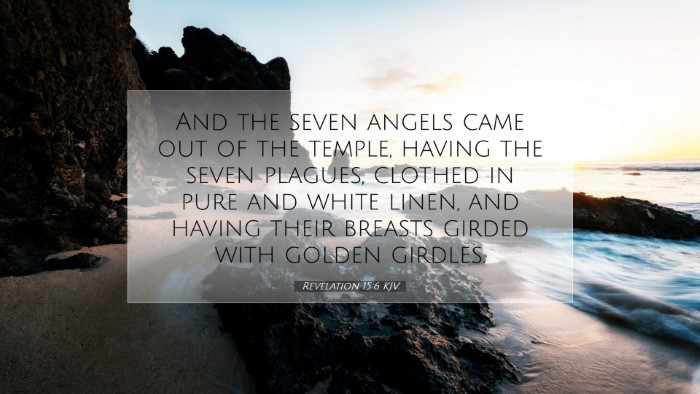Commentary on Revelation 15:6
Verse Context: Revelation 15:6 states, "And the seven angels came out of the temple, having the seven plagues, clothed in pure and white linen, and having their breasts girded with golden girdles." This passage marks a significant moment in the prophetic visions of John, highlighting themes central to eschatology and divine judgment.
Introduction
This commentary aims to explore the depths of Revelation 15:6, drawing insights from revered public domain commentators such as Matthew Henry, Albert Barnes, and Adam Clarke. In the context of the Book of Revelation, which reveals the final things—eschatology, divine judgment, and the ultimate redemption of creation—this verse stands as a pivotal point within the narrative of God's judgment upon the earth.
Analysis of the Verse
1. Symbolism of the Angels:
- Number Seven: The seven angels represent completeness and divine order in biblical numerology.
- Function: Their role is to execute God's final judgments, embodying both authority and responsibility.
- Clothing: The "pure and white linen" signifies purity, righteousness, and sanctity, reflecting the character of God and the holiness of their tasks.
Matthew Henry emphasizes the dignity of these angels and the purity of their garments, representing the righteousness required to administer divine justice. He notes that their coming out of the temple signifies the direct commission from the presence of God, underscoring that this judgment is a divine initiative, not of human origin.
2. The Temple Setting:
Albert Barnes elaborates that the temple is symbolic of God's presence and holiness. The angels emerging from the temple indicates that their missions are divinely ordained. This highlights the seriousness of the impending plagues, serving as reminders of the holiness of God and the inevitable nature of His judgment.
3. The Plagues:
The “seven plagues” are pivotal in Revelation, indicating God’s wrath against sin and disobedience. Adam Clarke posits that these are not arbitrary but are responses to unrepentant hearts, fulfilling the prophetic warnings throughout the Scriptures. The use of the word “plagues” evokes the ten plagues of Egypt, suggesting a severe and divine retribution against idolatry and moral decay.
Theological Implications
1. Eschatological Significance:
The imagery in Revelation 15:6 connects to the broader theme of end-time judgment prevalent throughout the New Testament. The travail of the angels can be seen as the culmination of God's plan for humanity, wherein justice is finally served and God’s holiness is vindicated.
2. Holiness of God:
This passage reminds scholars and theologians of the fervent holiness of God—a theme woven throughout Scripture. The angels, adorned in pure linen and golden girdles, stand as representatives of divine order, maintaining that God's judgments are always righteous and just. This is a critical reminder in our discourse surrounding God’s nature as both a just judge and merciful savior.
Practical Applications
1. Call to Holiness:
For pastors and church leaders, the imperative is to encourage a lifestyle of holiness among congregants, modeling after the angels who serve in purity and righteousness. Reflecting on the purity of their attire, believers are called to consider their own spiritual condition, striving for sanctification and holiness in their lives.
2. Understanding Divine Judgment:
The seriousness of God’s impending judgments serves as a wake-up call for communities of faith. How are believers today living in light of an approaching day of reckoning? Scholars, theologians, and pastors alike must engage with these themes, ensuring their congregants understand both the gravity of sin and the beauty of redemption.
Conclusion
Revelation 15:6 encapsulates a profound narrative of purity, judgment, and divine authority. When interpreted through the lenses of historical biblical scholarship, as presented by Henry, Barnes, and Clarke, the text offers rich theological insights that resonate deeply in contemporary faith discussions. As we contemplate these evocative images of angels and divine judgment, we are reminded of the holiness of God and the imperative of living lives aligned with His righteous expectations.


